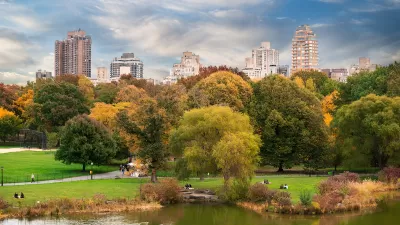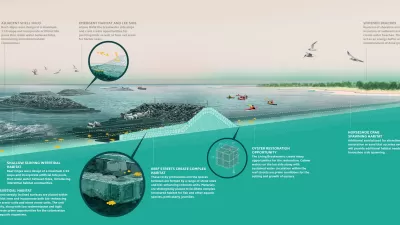A task force created by the White House in the aftermath of Hurricane Sandy has published its 69-point strategy for communities to better withstand and recover from extreme weather events.
"After Hurricane Sandy tore through the Northeast in December, killing 159 and causing $65 billion in damages, national attention focused on not only rebuilding devastated communities but also fortifying the coasts against future storms," writes Matt Bevilacqua.
"Now, a White House-created task force has come out with a strategy for better preparing cities across the country for increasingly common extreme weather events. The Hurricane Sandy Rebuilding Task Force, led by Housing and Urban Development Secretary Shaun Donovan, today released 69 policy recommendations that aim to streamline funding, give residents faster access to federal assistance, and develop regional approaches to disaster prep and response."
In this era of government disfunction, one promising element of the Task Force's work is their focus on implementation. "As laid out in the Rebuilding Strategy, the Task Force has also taken steps to ensure the implementation of these recommendations, each of which will be carried out by a Federal Department or Agency or an existing interagency working group," says a HUD press release announcing the report's publication. "Implementation will be tracked by a team which will also build on the Task Force Program Management Office’s work to track and release data on Federal spending from the Sandy supplemental funding bill."
FULL STORY: Feds Release Guidelines to Prepare for the Next Hurricane Sandy

Study: Maui’s Plan to Convert Vacation Rentals to Long-Term Housing Could Cause Nearly $1 Billion Economic Loss
The plan would reduce visitor accommodation by 25,% resulting in 1,900 jobs lost.

North Texas Transit Leaders Tout Benefits of TOD for Growing Region
At a summit focused on transit-oriented development, policymakers discussed how North Texas’ expanded light rail system can serve as a tool for economic growth.

Why Should We Subsidize Public Transportation?
Many public transit agencies face financial stress due to rising costs, declining fare revenue, and declining subsidies. Transit advocates must provide a strong business case for increasing public transit funding.

How Community Science Connects People, Parks, and Biodiversity
Community science engages people of all backgrounds in documenting local biodiversity, strengthening connections to nature, and contributing to global efforts like the City Nature Challenge to build a more inclusive and resilient future.

Alabama: Trump Terminates Settlements for Black Communities Harmed By Raw Sewage
Trump deemed the landmark civil rights agreement “illegal DEI and environmental justice policy.”

Dear Tesla Driver: “It’s not You, It’s Him.”
Amidst a booming bumper sticker industry, one writer offers solace to those asking, “Does this car make me look fascist?”
Urban Design for Planners 1: Software Tools
This six-course series explores essential urban design concepts using open source software and equips planners with the tools they need to participate fully in the urban design process.
Planning for Universal Design
Learn the tools for implementing Universal Design in planning regulations.
City of Santa Clarita
Ascent Environmental
Institute for Housing and Urban Development Studies (IHS)
City of Grandview
Harvard GSD Executive Education
Toledo-Lucas County Plan Commissions
Salt Lake City
NYU Wagner Graduate School of Public Service





























